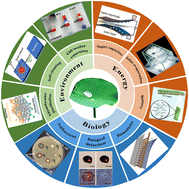Research progress on eco-friendly superhydrophobic materials in environment, energy and biology
Abstract
In the past few years, bioinspired eco-friendly superhydrophobic materials (EFSMs) have made great breakthroughs, especially in the fields of environment, energy and biology, which have made remarkable contributions to the sustainable development of the natural environment. However, some potential challenges still exist, which urgently need to be systematically summarized to guide the future development of this field. Herein, in this review, initially, we discuss the five typical superhydrophobic models, namely, the Wenzel, Cassie, Wenzel–Cassie, “lotus”, and “gecko” models. Then, the existence of superhydrophobic creatures in nature and artificial EFSMs are summarized. Then, we focus on the applications of EFSMs in the fields of environment (self-cleaning, wastewater purification, and membrane distillation), energy (solar evaporation, heat accumulation, and batteries), and biology (biosensors, biomedicine, antibacterial, and food packaging). Finally, the challenges and developments of eco-friendly superhydrophobic materials are highlighted.



 Please wait while we load your content...
Please wait while we load your content...